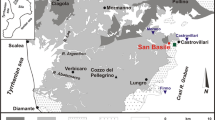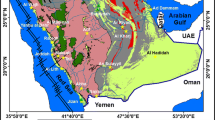Abstract
Sinkholes and land subsidence are among the main coastal geologic hazards. Their occurrence poses a serious threat to the man-made environment, due to the increasing density of population, pipelines and other infrastructures along the coasts, and to the catastrophic nature of the phenomena, which generally occur without any premonitory signs. To assess the potential danger from sinkholes along the coast, it is important to identify and monitor the main factors contributing to the process. This article reports a methodology based on sequential stratigraphic, hydrogeological and geophysical investigations to draw up a susceptibility map of sinkholes in coastal areas. The town of Casalabate situated in the Apulia region (southern Italy), affected by a long history of sinkhole phenomena, is here presented as an example. The approach proposed is based on sequential stratigraphical, geomorphological and geophysical surveys to identify the mechanisms of sinkhole formation and to provide a zonation of the areas in which further sinkhole phenomena may likely occur. Interpretation of the ground penetration radar and electrical tomography profiles has enabled us to identify the potentially most unstable sectors, significantly improving the assessment of the sinkhole susceptibility in the area. The proposed methodology is suitable to be exported in other coastal areas where limestone bedrock is not directly exposed at the surface, but covered by a variable thickness of recent deposits.










Similar content being viewed by others
References
Andriani G, Walsh N (2002) Physical properties and textural parameters of calcarenitic rocks: qualitative and quantitative evaluations. Eng Geol 67:5–15
Ardau F, Balia R, Bianco M, De Waele J (2007) Assessment of cover-collapse sinkholes in SW Sardinia (Italy). In: Parise M, Gunn J (eds) Natural and anthropogenic hazards in karst areas: recognition, analysis and mitigation. Geological Society, London, pp 47–57 Special publication 279
Boenzi F, Caldara M, Pennetta L, Simone O (2006) Environmental aspects related to the physical evolution of some wetlands along the Adriatic coast of Apulia (Southern Italy): a review. J Coast Res 39:170–175
Bosellini A, Bosellini FR, Colalongo ML, Parente M, Russo A, Vescogni A (1999) Stratigraphic architecture of the Salento coast from Capo d’Otranto to S. Maria di Leuca (Apulia, southern Italy). Riv Ital Paleontol Stratigr 105:397–415
Bossio A, Foresi ML, Margiotta S, Mazzei R, Salvatorini G, Donia F (2006) Stratigrafia neogenico-quaternaria del settore nord-orientale della Provincia di Lecce (con rilevamento geologico alla scala 1:25.000). Geologica Romana 39:63–88
Brezinski KD (2007) Geologic and anthropogenic factors influencing karst development in the Frederick region of Maryland. Environ Geosci 14(1):31–48
Bruno E, Calcaterra D, Parise M (2008) Development and morphometry of sinkholes in coastal plains of Apulia, southern Italy. Preliminary sinkhole susceptibility assessment. Eng Geol 99:198–209
Butler DK (1984) Microgravimetric and gravity gradient techniques for the detection of subsurface cavities. Geophysics 49:1084–1096
Cardarelli E, Cercato M, Cerreto A, Di Filippo G (2010) Electrical resistivity and seismic refraction tomography to detect buried cavities. Geophys Prospect 58:685–695
Cherubini C, Margiotta B, Sgura A, Walsh N (1987) Caratteri geologico-tecnici dei terreni della città di Brindisi. Mem Soc Geol Ital 37:689–700
Cotecchia V, Dai Pra G, Magri G (1969) Oscillazioni tirreniane e oloceniche del livello del mare nel Golfo di Taranto, corredate da datazioni con il metodo del radiocarbonio. Geol Appl Idrogeol 4:93–148
Cotecchia V, Dai Pra G, Magri G (1971) Sul Tirreniano della costa ionica salentina (Puglia). Datazione su campione di coralli con il metodo 230Th/234U. Geol Appl Idrogeol 6:105–112
De Groot-Hedlin C, Constable S (1990) Occam’s inversion to generate smooth, two-dimensional models from magnetotelluric data. Geophysics 55:1613–1624
De Waele J, Lauritzen SE, Parise M (2011a) On the formation of dissolution pipes in Quaternary coastal calcareous arenites in Mediterranean settings. Earth Surf Process Land 36:143–157
De Waele J, Gutierrez F, Parise M, Plan L (2011b) Geomorphology and natural hazards in karst areas: a review. Geomorphology 134:1–8
Del Prete S, Iovine G, Parise M, Santo A (2010) Origin and distribution of different types of sinkholes in the plain areas of Southern Italy. Geodinamica Acta 23(1/3):113–127
Delle Rose M, Leucci G (2010) Towards an integrated approach for characterization of sinkhole hazards in urban environments: the unstable coastal site of Casalabate, Lecce, Italy. J Geophys Eng 7:143–154
Delle Rose M, Parise M (2002) Karst subsidence in south-central Apulia. Italy Int J Speleol 31(1/4):181–199
Delle Rose M, Parise M (2004) Slope instability along the Adriatic coast of Salento, southern Italy. In: Proceedings of IX international symposium on landslides, Rio de Janeiro (Brasil), 28 June–2 July 2004, vol 1, pp 399–404
Delle Rose M, Parise M (2005) Speleogenesi e geomorfologia del sistema carsico delle Grotte della Poesia nell’ambito dell’evoluzione quaternaria della costa Adriatica Salentina. Atti e Memorie Commissione Grotte “E. Boegan” 40:153–173
Delle Rose M, Federico A, Parise M (2004) Sinkhole genesis and evolution in Apulia, and their interrelations with the anthropogenic environment. Nat Hazards Earth Syst Sci 4:747–755
Denitto F, Moscatello S, Palmisano P, Poto M, Onorato R (2006) Novità speleologiche, idrologiche e naturalistiche della Palude del Capitano (pSIC IT9150013), Costa Neretina (Lecce). Thalassia Salentina 29:99–116
Dobecki TL, Upchurch SB (2006) Geophysical applications to detect sinkholes and ground subsidence. Lead Edge 25:336–341
Edmonds C, Green C, Higginbottom I (1987) Subsidence hazard prediction for limestone terrains as applied to the English Cretaceous chalk. Geol Soc Eng, Special Publication 4, pp 283–293
Ezersky M (2008) Geoelectric structure of the Ein Gedi sinkhole occurrence site at the Dead Sea shore in Israel. J Appl Geophys 64:56–69
Ezersky M, Legchenko A, Camerlynck C, Al-Zoubi A (2009) Identification of sinkhole development mechanism based on a combined geophysical study in Nahal Hever South area (Dead Sea coast of Israel). Environ Geol 58:1123–1141
Folk RL (1974) Petrology of sedimentary rocks. Hemphill’s, Austin, TX
Forth RA, Butcher D, Senior R (1999) Hazard mapping of karst along the coast of the Algarve, Portugal. Eng Geol 52(1–2):67–74
Galve JP, Bonachea J, Remondo J, Gutierrez F, Guerrero J, Lucha P, Cendrero A, Gutierrez M, Sanchez JA (2008) Development and validation of sinkhole susceptibility models in mantled karst settings. A case study from the Ebro valley evaporite karst (NE Spain). Eng Geol 99:185–197
Garcia-Moreno I, Mateos RM (2011) Sinkholes related to discontinuous pumping: susceptibility mapping based on geophysical studies. The case of Crestatx (Majorca, Spain). Environ Earth Sci 64:523–537
Grandjean G, Leparoux D (2004) The potential of seismic methods for detecting cavities and buried objects: experimentation at a test site. J Appl Geophys 56:93–106
Gutierrez F (1998) Subsidencia por colapso en un karst alluvial. Analisis de estabilidad. In: Gomez-Ortiz A, Salvador Franch F (eds) Investigaciones recientes de la geomorfologia espanola. V Reunion Nacional de Geomorfologia, Barcelona, pp 47–58
Gutierrez-Santolalla F, Gutierrez Elorza M, Marin C, Desir G, Maldonado C (2005) Spatial distribution, morphometry and activity of La Puebla de Alfiden sinkhole field in the Ebro River Valley (NE Spain): applied aspects for hazard zonation. Environ Geol 48:360–369
Hall DR (1976) Stratigraphy and origin of surficial deposits in sinkholes in south-central Indiana. Geology 4(8):507–509
Harding JL (1999) Environmental change during the Holocene in south east Italy: an integrated geomorphological and palynological investigation. Larix Books, Sheffield, p 148
Hearty PJ, Dai Pra G (1992) The age and stratigraphy of Middle Pleistocene and younger deposits along the Gulf of Taranto (Southeast Italy). J Coastal Res 8:82–105
Jardani A, Revil A, Santos F, Fauchard C, Dupont JP (2007) Detection of referential infiltration pathways in sinkholes using joint inversion of self-potential and EM-34 conductivity data. Geophys Prospect 55:749–760
Kaufmann JE (2008) A statistical approach to karst collapse hazard analysis in Missouri. In: Yyuhr LB, Calvin Alexander E, Beck BF (eds) Sinkholes and the engineering and environmental impacts of karst, 183. ASCE Geotechnical Special Publication, Huntsville, pp 257–268
Kaufmann G, Romanov D, Nielbock R (2011) Cave detection using multiple geophysical methods: Unicorn cave, Harz Mountains, Germany. Geophysics 76(3):B71–B77
Kim JH, Yi MJ, Hwang SH, Song Y, Cho SJ, Synn JH (2007) Integrated geophysical surveys for the safety evaluation of a ground subsidence zone in a small city. J Geophys Eng 4:332–347
Kourgialas NN, Karatzas GP (2011) Flood management and a GIS modelling method to assess flood—hazard areas—a case study. Hydrol Sci J 56(2):212–225
Marcak H, Golebiowski T, Tomecka-Suchon S (2008) Geotechnical analysis and 4D GPR measurements for the assessment of the risk of sinkholes occurring in a Polish mining area. Near Surf Geophys 6(4):233–243
Margiotta B (1997) Dinamica degli spazi costieri: le Cesine (Lecce). Lecce, Oistros, p 61
Margiotta S, Negri S (2005) Geophysical and stratigraphical research into deep groundwater and intruding seawater in the Mediterranean area (the Salento Peninsula, Italy). Nat Hazards Earth Syst Sci 5:127–136
Margiotta S, Mazzone F, Negri S (2010) Stratigraphic revision of Brindisi-Taranto Plain: hydrogeological implications. Memorie Descrittive della Carta Geologica d’Italia 90:165–180
Mastronuzzi G, Sansò P (2002) Holocene coastal dune development and environmental changes in Apulia (southern Italy). Sediment Geol 150:139–152
Morelli G, Labrecque DJ (1996) Advances in ert inverse modelling. Eur J Environ Eng Geophys 1:171–186
Moretti M (2000) Soft-sediment deformation structures interpreted as seismites in middle-late Pleistocene eolian deposits (Apulian foreland, southern Italy). Sediment Geol 135:167–179
Moretti M, Owen G, Tropeano M (2011) Soft-sediment deformation induced by sinkhole activity in shallow marine environments: a fossil example in the Apulian Foreland (Southern Italy). Sediment Geol 235:331–342
Norris RM, Back W (1990) Erosion of seacliff by groundwater. In: Higgins CG, Coates DR (eds) Groundwater geomorphology: the role of subsurface water in earth-surface processes and landforms. Geological Society of America Special Paper 252, pp 283–290
Palmentola G (1987) Lineamenti geologici e morfologici del Salento leccese. Quad Ric Centro Studi Geotec e d’Ing 11:7–23
Parasnis DS (1997) Principles of applied geophysics, 5th edn. Chapman & Hall, London
Parise M (2008) I sinkholes in Puglia. In: Nisio S. (ed) I fenomeni naturali di sinkhole nelle aree di pianura italiane. Memorie Descrittive della Carta Geologica d’Italia 85:309–334
Parise M, Lollino P (2011) A preliminary analysis of failure mechanisms in karst and man-made underground caves in Southern Italy. Geomorphology 134(1–2):132–143
Primavera M, Simone O, Fiorentino G, Caldara M (2011) The paleoenvironmental study of the Alimini Piccolo Lake enables a reconstruction of Holocene sea level changes in southeast Italy. Holocene 21:553–563
Reynolds JM (1997) An introduction to applied and environmental geophysics. Wiley, New York
Tharp TM (1999) Mechanics of upward propagation of cover collapse sinkhole. Eng Geol 52:23–33
Tharp TM (2002) Poroelastic analysis of cover-collapse sinkhole formation by piezometric surface drawdown. Environ Geol 42:447–456
Tolmachev V, Leonenko M (2011) Experience in collapse risk assessment of building on covered karst landscapes in Russia. In: van Beynen P (ed) Karst management. Springer, Berlin, pp 75–102
van Schoor M (2002) Detection of sinkholes using 2D electrical resistivity imaging. J Appl Geophys 50:393–399
Waltham T, Bell FG, Culshaw MG (2005) Sinkholes and subsidence: karst and cavernous rocks in engineering and construction. Springer, Praxis, p 382
White WB (1990) Surface and near-surface karst landforms. In: Higgins CG, Coates DR (eds) Groundwater geomorphology: the role of subsurface water in earth-surface processes and landforms. Geological Society of America Special Paper 252, pp 157–175
Zhou W, Beck BF (2008) Management and mitigation of sinkholes on karst lands: an overview of practical applications. Env Geol 55:837–851
Author information
Authors and Affiliations
Corresponding author
Rights and permissions
About this article
Cite this article
Margiotta, S., Negri, S., Parise, M. et al. Mapping the susceptibility to sinkholes in coastal areas, based on stratigraphy, geomorphology and geophysics. Nat Hazards 62, 657–676 (2012). https://doi.org/10.1007/s11069-012-0100-1
Received:
Accepted:
Published:
Issue Date:
DOI: https://doi.org/10.1007/s11069-012-0100-1




